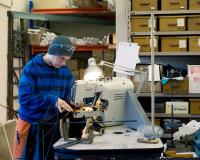 Add My Company
Add My Company
Sign In
At James Ince & Sons, Umbrella Makers
20-01-2011

The factory of James Ince & Sons, the oldest established umbrella makers in the country, is one of the few places in London where you will not hear complaints about the rainy weather, because – while our moist climate is such a disappointment to the population in general – it has happily sustained generations of Inces for over two centuries now. If you walked down Whites Row in Spitalfields in 1824, you would have found William Ince making umbrellas and this week, six generations later, I was able to visit Richard Ince, still making umbrellas in the East End. Yet although the date of origin of the company is conservatively set at 1805, there was a William Inch, a tailor listed in Spitalfields in 1793, who may have been father to William Ince of Whites Row – which makes it credible to surmise that Inces have been making umbrellas since they first became popular at the end of the eighteenth century.
You might assume that the weight of so much history weighs heavily upon Richard Ince, but it is like water off a duck’s back to him, because he is simply too busy manufacturing umbrellas. Richard’s father and grandfather were managers with a large staff of employees, but Richard is one of only four workers at James Ince & Sons today, and he works alongside his colleagues as one of the team, cutting and stitching, personally supervising all the orders. Watching them at work this week, it was a glimpse of what William Ince’s workshop might have been like in Spitalfields in 1824, because – although synthetics and steel have replaced silk and whalebone, and all stitching is done by machine now – the essential design and manufacturing process of umbrellas remains the same.
Between these two workshops of William Ince in 1824 and Richard Ince in 2011, exists a majestic history, which might be best described as one of gracious expansion and then sudden contraction, in the manner of an umbrella itself. It was the necessity of silk that made Spitalfields the natural home for James Ince & Sons. The company prospered there during the expansion of London through the nineteenth century and the increase in colonial trade, especially to India and Burma. In 1837, they moved into larger premises in Brushfield St and, by 1857, filled a building on Bishopsgate too. In the twentieth century, workers at Inces’ factory in Spitalfields took cover in the basement during air raids, and then emerged to resume making military umbrellas for soldiers in the trenches during the First World War and canvas covers for guns during the Second World War. Luckily, the factory itself narrowly survived a flying bomb, permitting the company to enjoy post-war success, diversifying into angling umbrellas, golfing umbrellas, sun umbrellas and promotional umbrellas, even a ceremonial umbrella for a Nigerian Chief. But in the nineteen eighties, a change in tax law, meaning that umbrella makers could no longer be classed as self-employed, challenged the viability of the company, causing James Ince & Sons to shed most of the staff and move to smaller premises in Hackney.
This is some of the history that Richard Ince does not think about very much, whilst deeply engaged through every working hour with the elegant contrivance of making umbrellas. In the twenty-first century, James Ince & Sons fashion the umbrellas for Rubeus Hagrid and Mary Poppins, surely the most famous brollies on the planet. A fact which permits Richard a small, yet justly deserved, smile of satisfaction as the proper outcome of more than two hundred years of umbrella making by seven generations of his family. A smile that in its quiet intensity reveals his passion for his calling. “My father didn’t want to do it,” he admitted with a grin of regret, “but I left school at seventeen and I felt my way in. I used to spend my Saturdays in Spitalfields, kicking cabbages around as footballs, and when we had the big tax problem, it taught me that I had to get involved.” This was how Richard oversaw the transformation of his company to become the lean operation it is today. “We are the only people who are prepared to look at making weird umbrellas, when they want strange ones for film and theatre.” he confessed with yet another modest smile, as if this indication of his expertise were a mere admission of amiable gullibility.
On the ground floor of his factory in Vyner St, is a long block where Richard unfurls the rolls of fabric and cuts the umbrella panels using a wooden pattern and a sharp knife. Then he carries the armful of pieces upstairs to Rita Smith, the irresistibly charming machinist with vivid green eyes that match her uniform, who sits perched by the window eager to sew the panels together, deploying a deceptively casual expertise honed over sixty years at her machine. Seventy-six year old Rita has sewn umbrella covers for three generations of Inces, Richard, Wilfred and Geoffrey, Richard’s father, whose picture she glances at occasionally for reassurance, high upon the wall in the workroom. “I never wanted to try anything else. My Aunt Eva got me the job when I was fifteen and I worked beside her at first. If I got it wrong, she said, ‘Do it again or I’ll knock you off your chair!'” confided Rita to me mischievously, enacting the role of Aunt Eva with fearsome conviction. “I started in Spitalfields in 1950 as a machinist.” she continued brightly, “Upstairs there used to be a cutter for ladies and gentlemen’s umbrellas and one for garden umbrellas, and below four machinists who did garden umbrellas and three who did ladies and gents’ and golf umbrellas, as well as six ‘tippers’ who sewed the covers on by hand.” All the time Rita spoke, she worked, almost automatically, sewing the triangular panels of slippery fabric in pairs, combining them into fours and then adding a thin, perfectly even seam, all round the circumference once she had made a complete cover of eight pieces.
As soon as the covers are sewn, Job Forster takes them and does the “tipping,” consisting of fixing the “points” (which attach the cover to the ends of the ribs), sewing the cover to the frame and adding the tie which is used to furl the umbrella when not in use. Job was making some huge umbrellas for The Berkeley, used by the doormen to shepherd guests through the rain, and I watched as he clamped the bare metal frame to the bench, revolving it as he stitched the cover to each rib in turn, to complete the umbrella. Then came the moment when Job opened it up to scrutinise his handiwork. With a satisfying “thunk,” the black cover expanded like a giant bat stretching its wings taut and I was spellbound by the drama of the moment – because now I understood what it takes to make one, I was seeing an umbrella for the first time, thanks to James Ince & Sons (Umbrella Makers) Ltd.
For more information on At James Ince & Sons, Umbrella Makers talk to James Ince & Sons (Umbrellas) Ltd
Enquire Now
List your company on FindTheNeedle.

